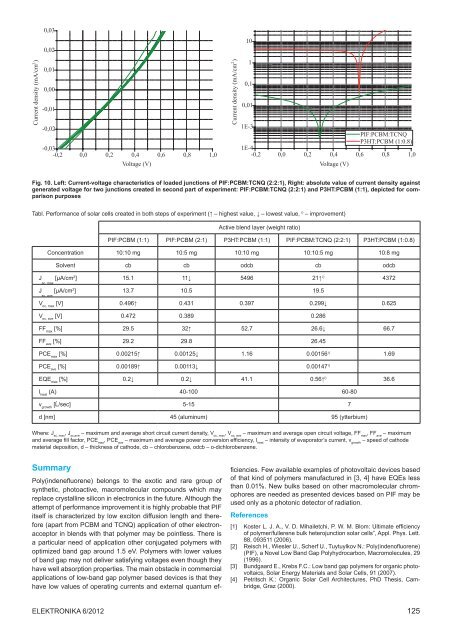Proceedings of the European Summer School of Photovoltaics 4 â 7 ...
Proceedings of the European Summer School of Photovoltaics 4 â 7 ...
Proceedings of the European Summer School of Photovoltaics 4 â 7 ...
You also want an ePaper? Increase the reach of your titles
YUMPU automatically turns print PDFs into web optimized ePapers that Google loves.
0,03<br />
0,02<br />
10<br />
Current density (mA/cm 2 )<br />
0,01<br />
0,00<br />
-0,01<br />
-0,02<br />
-0,03<br />
-0,2 0,0 0,2 0,4 0,6 0,8 1,0<br />
Voltage (V)<br />
Current density (mA/cm 2 )<br />
1<br />
0,1<br />
0,01<br />
1E-3<br />
PIF:PCBM:TCNQ<br />
P3HT:PCBM (1:0.8)<br />
1E-4<br />
-0,2 0,0 0,2 0,4 0,6 0,8 1,0<br />
Voltage (V)<br />
Fig. 10. Left: Current-voltage characteristics <strong>of</strong> loaded junctions <strong>of</strong> PIF:PCBM:TCNQ (2:2:1), Right: absolute value <strong>of</strong> current density against<br />
generated voltage for two junctions created in second part <strong>of</strong> experiment: PIF:PCBM:TCNQ (2:2:1) and P3HT:PCBM (1:1), depicted for comparison<br />
purposes<br />
Tabl. Performance <strong>of</strong> solar cells created in both steps <strong>of</strong> experiment (↑ – highest value, ↓ – lowest value, i) – improvement)<br />
Active blend layer (weight ratio)<br />
PIF:PCBM (1:1) PIF:PCBM (2:1) P3HT:PCBM (1:1) PIF:PCBM:TCNQ (2:2:1) P3HT:PCBM (1:0.8)<br />
Concentration 10:10 mg 10:5 mg 10:10 mg 10:10:5 mg 10:8 mg<br />
Solvent cb cb odcb cb odcb<br />
Jsc, max [µA/cm2 ] 15.1 11↓ 5496 21↑ i) 4372<br />
J [µA/cm 2 ] 13.7 10.5 19.5<br />
sc, ave<br />
V oc, max<br />
[V] 0.496↑ 0.431 0.397 0.299↓ 0.625<br />
V oc, ave<br />
[V] 0.472 0.389 0.286<br />
FF max<br />
[%] 29.5 32↑ 52.7 26.6↓ 66.7<br />
FF ave<br />
[%] 29.2 29.8 26.45<br />
PCE max<br />
[%] 0.00215↑ 0.00125↓ 1.16 0.00156 i) 1.69<br />
PCE ave<br />
[%] 0.00189↑ 0.00113↓ 0.00147 i)<br />
EQE max<br />
[%] 0.2↓ 0.2↓ 41.1 0.56↑ i) 36.6<br />
I heat<br />
(A) 40-100 60-80<br />
v growth<br />
[Ĺ/sec] 5-15 7<br />
d [nm] 45 (aluminum) 95 (ytterbium)<br />
Where: J sc, max<br />
, J sc,ave<br />
– maximum and average short circuit current density, V oc, max<br />
, V oc, ave<br />
– maximum and average open circuit voltage, FF max<br />
, FF ave<br />
– maximum<br />
and average fill factor, PCE max<br />
, PCE ave<br />
– maximum and average power conversion efficiency, I heat<br />
– intensity <strong>of</strong> evaporator’s current, v growth<br />
– speed <strong>of</strong> cathode<br />
material deposition, d – thickness <strong>of</strong> cathode, cb – chlorobenzene, odcb – o-dichlorobenzene.<br />
Summary<br />
Poly(indenefluorene) belongs to <strong>the</strong> exotic and rare group <strong>of</strong><br />
syn<strong>the</strong>tic, photoactive, macromolecular compounds which may<br />
replace crystalline silicon in electronics in <strong>the</strong> future. Although <strong>the</strong><br />
attempt <strong>of</strong> performance improvement it is highly probable that PIF<br />
itself is characterized by low exciton diffusion length and <strong>the</strong>refore<br />
(apart from PCBM and TCNQ) application <strong>of</strong> o<strong>the</strong>r electronacceptor<br />
in blends with that polymer may be pointless. There is<br />
a particular need <strong>of</strong> application o<strong>the</strong>r conjugated polymers with<br />
optimized band gap around 1.5 eV. Polymers with lower values<br />
<strong>of</strong> band gap may not deliver satisfying voltages even though <strong>the</strong>y<br />
have well absorption properties. The main obstacle in commercial<br />
applications <strong>of</strong> low-band gap polymer based devices is that <strong>the</strong>y<br />
have low values <strong>of</strong> operating currents and external quantum efficiencies.<br />
Few available examples <strong>of</strong> photovoltaic devices based<br />
<strong>of</strong> that kind <strong>of</strong> polymers manufactured in [3, 4] have EQEs less<br />
than 0.01%. New bulks based on o<strong>the</strong>r macromolecular chromophores<br />
are needed as presented devices based on PIF may be<br />
used only as a photonic detector <strong>of</strong> radiation.<br />
References<br />
[1] Koster L. J. A., V. D. Mihailetchi, P. W. M. Blom: Ultimate efficiency<br />
<strong>of</strong> polymer/fullerene bulk heterojunction solar cells”, Appl. Phys. Lett.<br />
88, 093511 (2006).<br />
[2] Reisch H., Wiesler U., Scherf U., Tuytuylkov N.: Poly(inden<strong>of</strong>luorene)<br />
(PIF), a Novel Low Band Gap Polyhydrocarbon, Macromolecules, 29<br />
(1996).<br />
[3] Bundgaard E., Krebs F.C.: Low band gap polymers for organic photovoltaics,<br />
Solar Energy Materials and Solar Cells, 91 (2007).<br />
[4] Petritsch K.: Organic Solar Cell Architectures, PhD Thesis, Cambridge,<br />
Graz (2000).<br />
Elektronika 6/2012 125

















